A Novel Computer-Aided Detection/Diagnosis System for Detection and Classification of Polyps in Colonoscopy
Abstract
1. Introduction
- For a comprehensive and balanced model of colon polyp classification, the shortage of an SSA is an issue. We supplemented it with the GAN method and achieved superior results compared with the data augmentation technique.
- The blurriness caused by the endoscopy movement decreases polyp detection accuracy. We used a motion-blurred restoration model to deblur the images and improve the detection.
- Our GAN-generated database on the state-of-the-art YOLOv5 algorithm performs outstanding compared with other algorithms.
- The add-on effect of the GAN method increases the accuracy of polyp detection and classification compared with other studies.
2. Related Studies
3. Materials and Methods
3.1. Modifying the Aspect Ratios of GAN Training Data
3.2. GAN Training Data Labeling
3.3. Finding Contours Using the Canny Algorithm
3.4. Overlaying a Contour Map on a Ground Truth Map
3.5. Overlaying the Ground Truth Map onto the Original Image
3.6. Conditional GAN Architecture
3.7. Comparison of GAN Output
3.7.1. Peak Signal-to-Noise Ratio (PSNR)
3.7.2. Structural Similarity Index Measure (SSIM)
3.8. YOLO Data Labeling
3.9. YOLO Data Augmentation
- (a)
- A random rotation of the image within plus or minus 45 degrees.
- (b)
- Random horizontal and vertical shifts of 20% were made toward the left and right sides of the image, respectively.
- (c)
- Random zoom in or out of the image (80–120% of the original image).
- (d)
- We ensured that the ground truth remained in the image when the above actions were conducted.
3.10. Training YOLO
3.11. Comparison of Model Metrics
3.12. Gaussian Blurring of the Test Video
3.13. Evaluating the Deblurring Effect
4. Results
4.1. Comparison of GAN-Generated Images
4.2. Comparison of YOLO Using Different Datasets
4.3. Comparison of Gaussian Blur and DeblurGAN-v2
4.4. Comparison of YOLO Using DeblurGAN-v2
4.5. Performance Comparison with Other Object Detection and Classification Models
4.6. Model Optimization
5. Discussion
6. Conclusions
Author Contributions
Funding
Institutional Review Board Statement
Informed Consent Statement
Data Availability Statement
Conflicts of Interest
References
- Colorectal Cancer Prevention (American Association for Cancer Research), USA. Available online: https://www.aacr.org/patients-caregivers/about-cancer/cancer-prevention/ (accessed on 23 December 2021).
- Corley, D.A.; Jensen, C.D.; Marks, A.R.; Zhao, W.K.; Lee, J.K.; Doubeni, C.A.; Zauber, A.G.; de Boer, J.; Fireman, B.H.; Schottinger, J.E.; et al. Adenoma detection rate and risk of colorectal cancer and death. N. Engl. J. Med. 2014, 370, 1298–1306. [Google Scholar] [CrossRef] [PubMed]
- Zhao, S.; Wang, S.; Pan, P.; Xia, T.; Chang, X.; Yang, X.; Guo, L.; Meng, Q.; Yang, F.; Qian, W.; et al. Magnitude, risk factors, and factors associated with adenoma miss rate of tandem colonoscopy: A systematic review and meta-analysis. Gastroenterology 2019, 156, 1661–1674. [Google Scholar] [CrossRef] [PubMed]
- Introduction to Colorectal Cancer Screening by the National Health Agency, Ministry of Health and Welfare, Taiwan. Available online: https://www.hpa.gov.tw/Pages/Detail.aspx?nodeid=621&pid=1136 (accessed on 23 December 2021).
- Hassan, C.; Pickhardt, P.J.; Rex, D.K. A resect and discard strategy would improve cost-effectiveness of colorectal cancer screening. Clin. Gastroenterol. Hepatol. 2010, 8, 865–869. [Google Scholar] [CrossRef] [PubMed]
- Zachariah, R.; Samarasena, J.; Luba, D.; Duh, E.; Dao, T.; Requa, J.; Ninh, A.; Karnes, W. Prediction of Polyp Pathology Using Convolutional Neural Networks Achieves‘Resect and Discard’Thresholds. Am. J. Gastroenterol. 2020, 115, 138. [Google Scholar] [CrossRef]
- Duong, A.; Pohl, H.; Djinbachian, R.; Deshêtres, A.; Barkun, A.N.; Marques, P.N.; Bouin, M.; Deslandres, E.; Aguilera-Fish, A.; Leduc, R.; et al. Evaluation of the polyp-based resect and discard strategy: A retrospective study. Endoscopy 2022, 54, 128–135. [Google Scholar] [CrossRef]
- Tang, C.P.; Chen, K.H.; Lin, T.L. Computer-Aided Colon Polyp Detection on High Resolution Colonoscopy Using Transfer Learning Techniques. Sensors 2021, 21, 5315. [Google Scholar] [CrossRef]
- Tang, C.P.; Shao, P.P.; Hsieh, Y.H. A review of water exchange and artificial intelligence in improving adenoma detection. Tzu-Chi Med. J. 2021, 33, 108–114. [Google Scholar]
- Kaul, V.; Enslin, S.; Gross, S.A. History of artificial intelligence in medicine. Gastrointest. Endosc. 2020, 92, 807–812. [Google Scholar] [CrossRef]
- Kulkarni, S.; Seneviratne, N.; Baig, M.S.; Khan, A.H.A. Artificial intelligence in medicine: Where are we now? Acad. Radiol. 2020, 27, 62–70. [Google Scholar] [CrossRef]
- Domingos, P. A few useful things to know about machine learning. Commun. ACM 2012, 55, 78–87. [Google Scholar] [CrossRef]
- Shin, H.C.; Roth, H.R.; Gao, M.; Lu, L.; Xu, Z.; Nogues, I.; Yao, J.; Mollura, D.; Summers, R.M. Deep convolutional neural networks for computer-aided detection: CNN architectures, dataset characteristics and transfer learning. IEEE Trans. Med. Imaging 2016, 35, 1285–1298. [Google Scholar] [CrossRef] [PubMed]
- Johnson, J.M.; Khoshgoftaar, T.M. Survey on deep learning with class imbalance. J. Big Data 2019, 6, 1–54. [Google Scholar] [CrossRef]
- Cenggoro, T.W. Deep learning for imbalance data classification using class expert generative adversarial network. Procedia Comput. Sci. 2018, 135, 60–67. [Google Scholar]
- Puyol-Antón, E.; Ruijsink, B.; Piechnik, S.K.; Neubauer, S.; Petersen, S.E.; Razavi, R.; King, A.P. Fairness in cardiac mr image analysis: An investigation of bias due to data imbalance in deep learning based segmentation. In International Conference on Medical Image Computing and Computer-Assisted Intervention; Springer: Cham, Switzerland, 2021; pp. 413–423. [Google Scholar]
- Chiu, T.W.; Tsai, Y.L.; Su, S.F. Automatic detect lung node with deep learning in segmentation and imbalance data labeling. Sci. Rep. 2021, 11, 11174. [Google Scholar] [CrossRef]
- Fonollà, R.; EW van der Zander, Q.; Schreuder, R.M.; Masclee, A.A.M.; Schoon, E.J.; van der Sommen, F.; de With, P.H.N. A CNN CADx System for Multimodal Classification of Colorectal Polyps Combining WL, BLI, and LCI Modalities. Appl. Sci. 2020, 10, 5040. [Google Scholar] [CrossRef]
- Patino-Barrientos, S.; Sierra-Sosa, D.; Garcia-Zapirain, B.; Castillo-Olea, C.; Elmaghraby, A. Kudo’s Classification for Colon Polyps Assessment Using a Deep Learning Approach. Appl. Sci. 2020, 10, 501. [Google Scholar] [CrossRef]
- Tischendorf, J.J.W.; Gross, S.; Winograd, R.; Hecker, H.; Auer, R.; Behrens, A.; Trautwein, C.; Aach, T.; Stehle, T. Computer-aided classification of colorectal polyps based on vascular patterns: A pilot study. Endoscopy 2010, 42, 203–207. [Google Scholar] [CrossRef]
- Komeda, Y.; Handa, H.; Watanabe, T.; Nomura, T.; Kitahashi, M.; Sakurai, T.; Okamoto, A.; Minami, T.; Kono, M.; Arizumi, T.; et al. Computer-aided diagnosis based on convolutional neural network system for colorectal polyp classification: Preliminary experience. Oncology 2017, 93, 30–34. [Google Scholar] [CrossRef]
- Gross, S.; Trautwein, C.; Behrens, A.; Winograd, R.; Palm, S.; Lutz, H.H.; Schirin-Sokhan, R.; Hecker, H.; Aach, T.; Tischendorf, J.J. Computer-based classification of small colorectal polyps by using narrow-band imaging with optical magnification. Gastrointest. Endosc. 2011, 74, 1354–1359. [Google Scholar] [CrossRef]
- Ozawa, T.; Ishihara, S.; Fujishiro, M.; Kumagai, Y.; Shichijo, S.; Tada, T. Automated endoscopic detection and classification of colorectal polyps using convolutional neural networks. Ther. Adv. Gastroenterol. 2020, 13, 1756284820910659. [Google Scholar] [CrossRef]
- Urban, G.; Tripathi, P.; Alkayali, T.; Mittal, M.; Jalali, F.; Karnes, W.; Baldi, P. Deep learning localizes and identifies polyps in real time with 96% accuracy in screening colonoscopy. Gastroenterology 2018, 155, 1069–1078. [Google Scholar] [CrossRef] [PubMed]
- Wang, P.; Xiao, X.; Glissen Brown, J.R.; Berzin, T.M.; Tu, M.; Xiong, F.; Hu, X.; Liu, P.; Song, Y.; Zhang, D.; et al. Development and validation of a deep-learning algorithm for the detection of polyps during colonoscopy. Nat. Biomed. Eng. 2018, 2, 741–748. [Google Scholar] [CrossRef] [PubMed]
- Qadir, H.A.; Shin, Y.; Solhusvik, J.; Bergsland, J.; Aabakken, L.; Balasingham, I. Polyp detection and segmentation using mask R-CNN: Does a deeper feature extractor cnn always perform better? In Proceedings of the 2019 13th International Symposium on Medical Information and Communication Technology (ISMICT), Oslo, Norway, 8–9 May 2019. [Google Scholar]
- Sánchez-Peralta, L.F.; Pagador, J.B.; Picón, A.; Calderón, Á.J.; Polo, F.; Andraka, N.; Bilbao, R.; Glover, B.; Saratxaga, C.L.; Sánchez-Margallo, F.M. PICCOLO white-light and narrow-band imaging colonoscopic dataset: A performance comparative of models and datasets. Appl. Sci. 2020, 10, 8501. [Google Scholar] [CrossRef]
- Li, T.; Brown, J.R.G.; Tsourides, K.; Mahmud, N.; Cohen, J.M.; Berzin, T.M. Training a computer-aided polyp detection system to detect sessile serrated adenomas using public domain colonoscopy videos. Endoscopy 2020, 8, E1448–E1454. [Google Scholar] [CrossRef]
- Shin, Y.; Qadir, H.A.; Aabakken, L.; Bergsland, J.; Balasingham, I. Automatic colon polyp detection using region based deep CNN and post learning approaches. IEEE Access 2018, 6, 40950–40962. [Google Scholar] [CrossRef]
- Isola, P.; Zhu, J.Y.; Zhou, T.; Efros, A.A. Image-to-Image Translation with Conditional Adversarial Networks (Pix2Pix). In Proceedings of the 2017 IEEE Conference on Computer Vision and Pattern Recognition (CVPR), Honolulu, HI, USA, 21–26 July 2017. [Google Scholar]
- Jocher, G.; Stoken, A.; Borovec, J.; Hogan, A.; Chaurasia, A.; Diaconu, L.; Yu, L.; Doan, K.; Kim, J.; Fang, J.; et al. Ultralytics/yolov5: v4.0-nn.SiLU() activations, Weights & Biases Logging, PyTorch Hub Integration. Available online: https://zenodo.org/record/4418161#.Y7T7pRVBxPY (accessed on 31 December 2022).
- Queiroz, F.; and Ren, T.I. Endoscopy image restoration: A study of the kernel estimation from specular highlights. Digit. Signal Process. 2019, 88, 53–65. [Google Scholar] [CrossRef]
- Takamatsu, M.; Hasegawa, M. Architecture for accurate polyp segmentation in motion-blurred colonoscopy images. In Proceedings of the 19th IEEE International Conference on Machine Learning and Applications (ICMLA), Miami, FL, USA, 14–17 December 2020; pp. 1087–1093. [Google Scholar]
- Park, J.; Hwang, Y.; Yoon, J.H.; Park, M.G.; Kim, J.; Lim, Y.J.; Chun, H.J. Recent development of computer vision technology to improve capsule endoscopy. Clin. Endosc. 2019, 52, 328–333. [Google Scholar] [CrossRef]
- Ali, S.; Zhou, F.; Bailey, A.; Braden, B.; East, J.E.; Lu, X.; Rittscher, J. A deep learning framework for quality assessment and restoration in video endoscopy. Med. Image Anal. 2021, 68, 101900. [Google Scholar] [CrossRef]
- Brandao, P.; Mazomenos, E.; Ciuti, G.; Caliò, R.; Bianchi, F.; Menciassi, A.; Dario, P.; Koulaouzidis, A.; Arezzo, A.; Stoyanov, D. Fully convolutional neural networks for polyp segmentation in colonoscopy. In Medical Imaging 2017: Computer-Aided Diagnosis; SPIE: Bellingham, DC, USA, 2017; Volume 10134, p. 101340. [Google Scholar]
- Fan, D.P.; Ji, G.P.; Zhou, T.; Chen, G.; Fu, H.; Shen, J.; Shao, L. PraNet: Parallel Reverse Attention Network for Polyp Segmentation. In Proceedings of the International Conference on Medical Image Computing and Computer-Assisted Intervention, Lima, Peru, 4–8 October 2020. [Google Scholar]
- Jha, D.; Riegler, M.A.; Johansen, D.; Halvorsen, P.; Johansen, H.D. DoubleU-Net: A Deep Convolutional Neural Network for Medical Image Segmentation. In Proceedings of the 2020 IEEE 33rd International Symposium on Computer-Based Medical Systems (CBMS), Rochester, MN, USA, 28–30 July 2020. [Google Scholar]
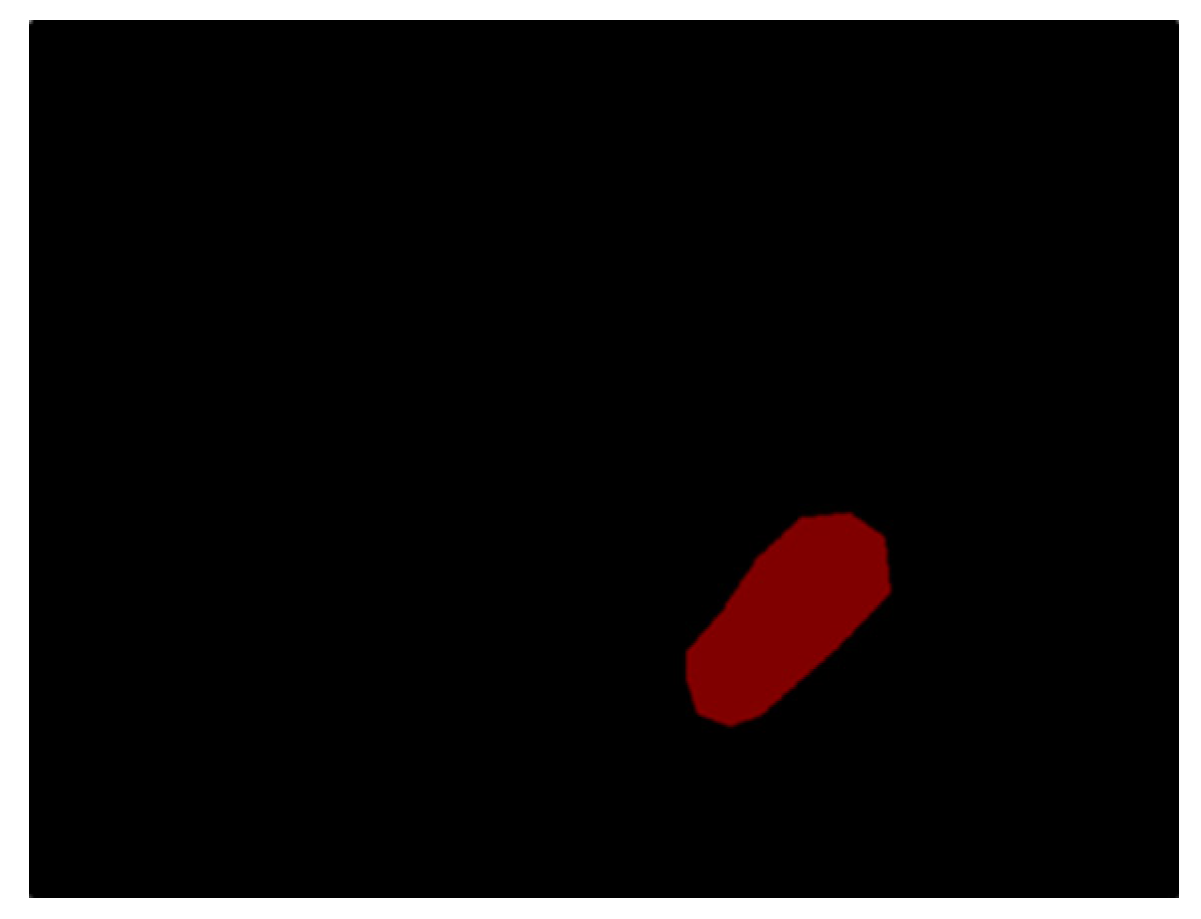
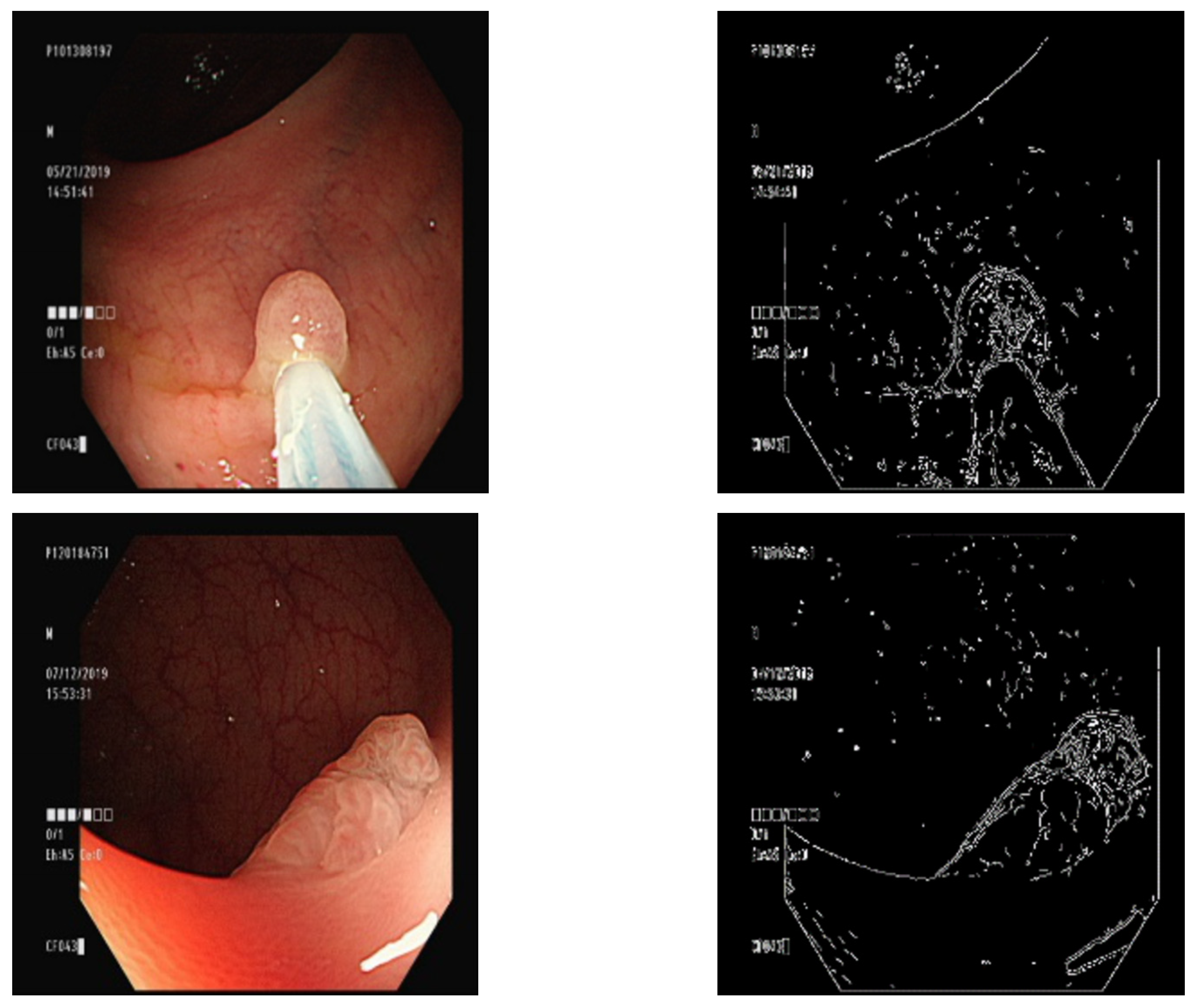
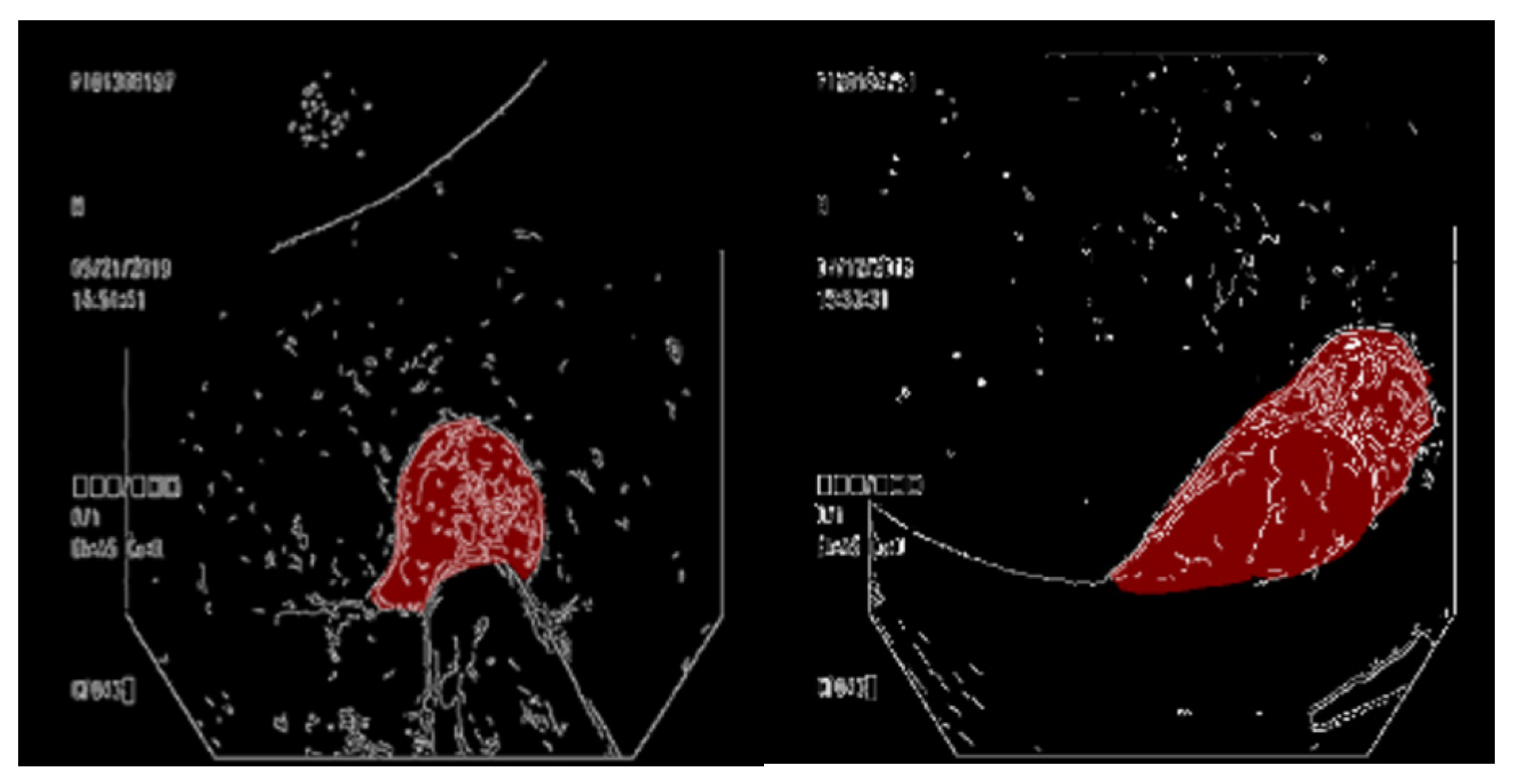
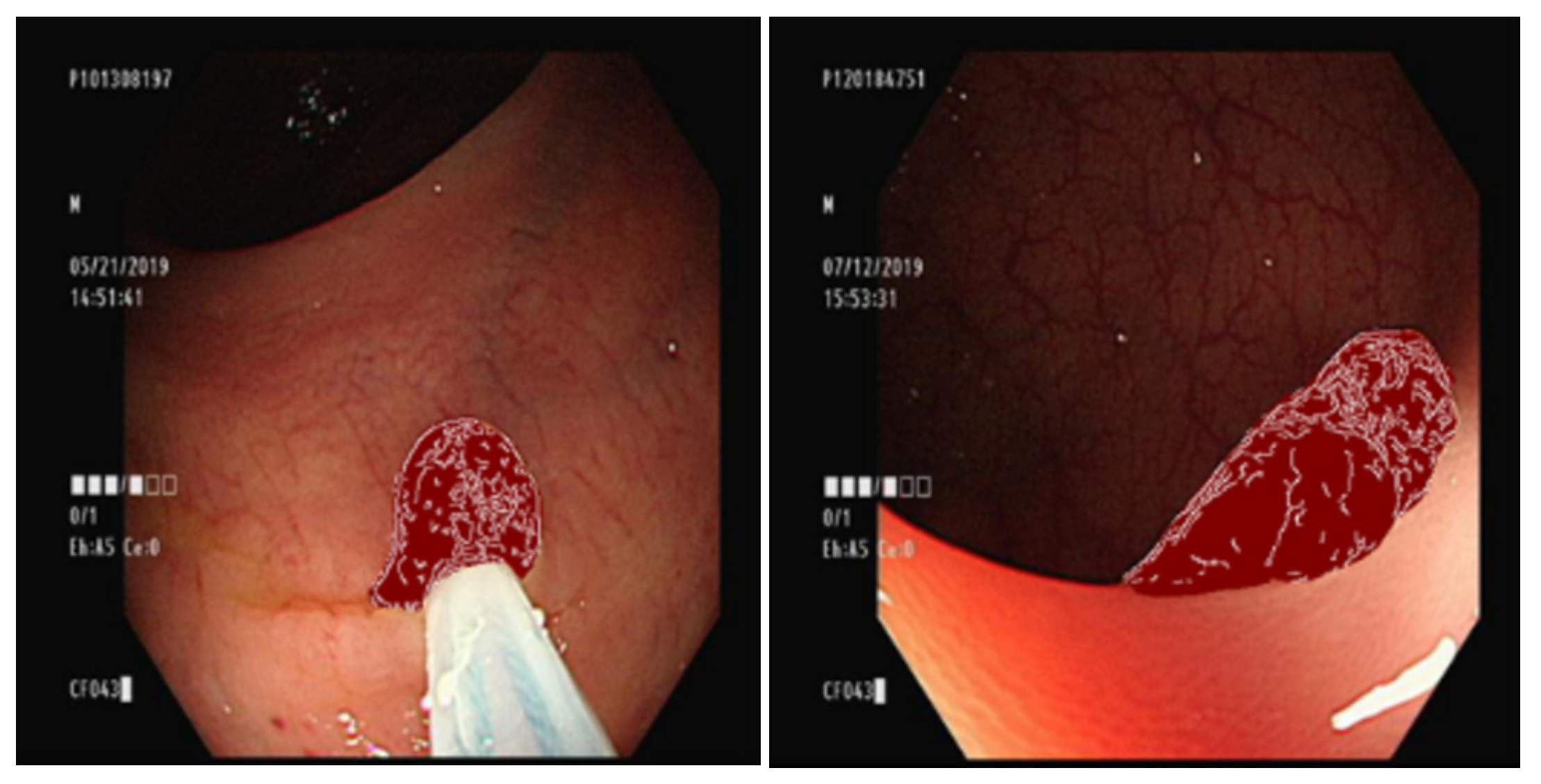
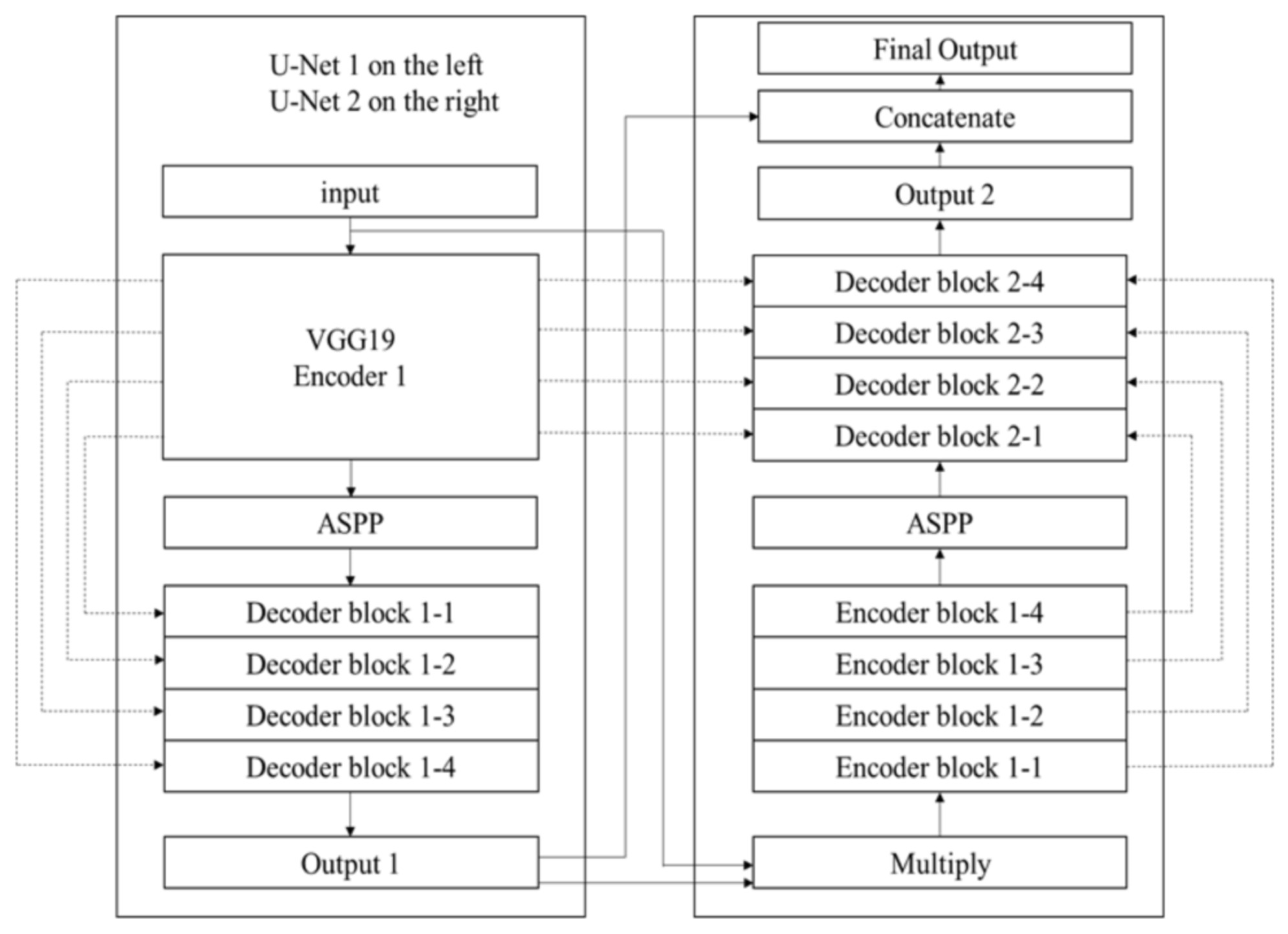
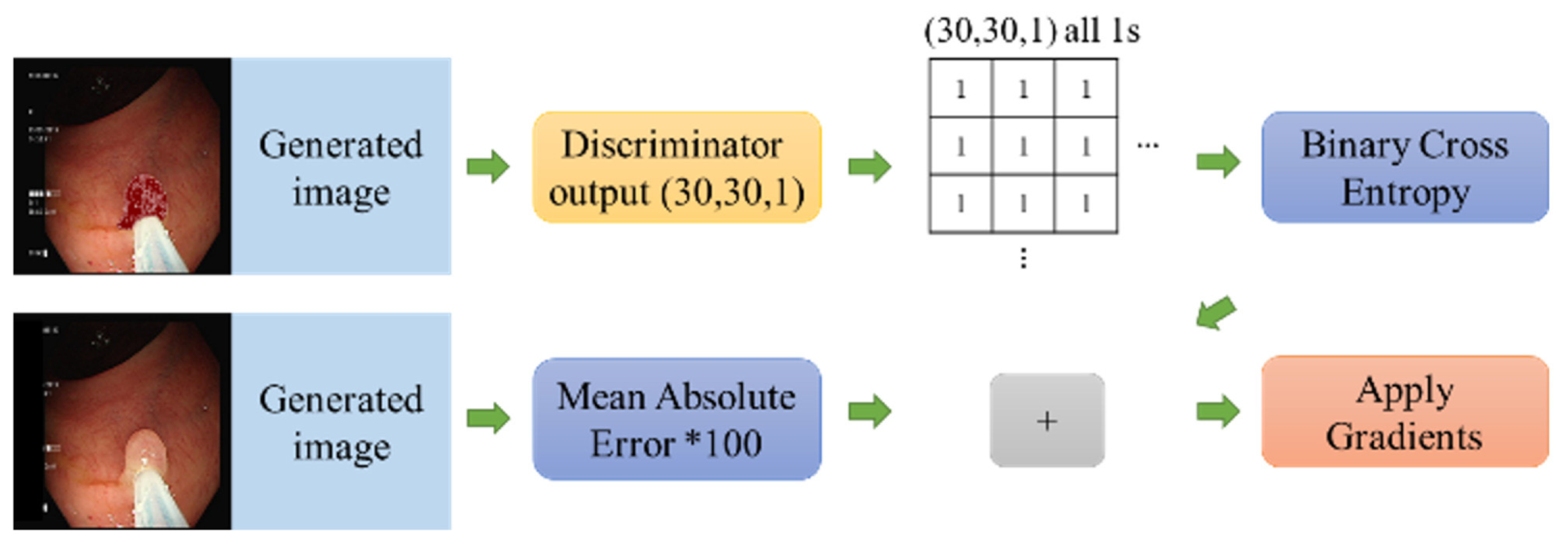
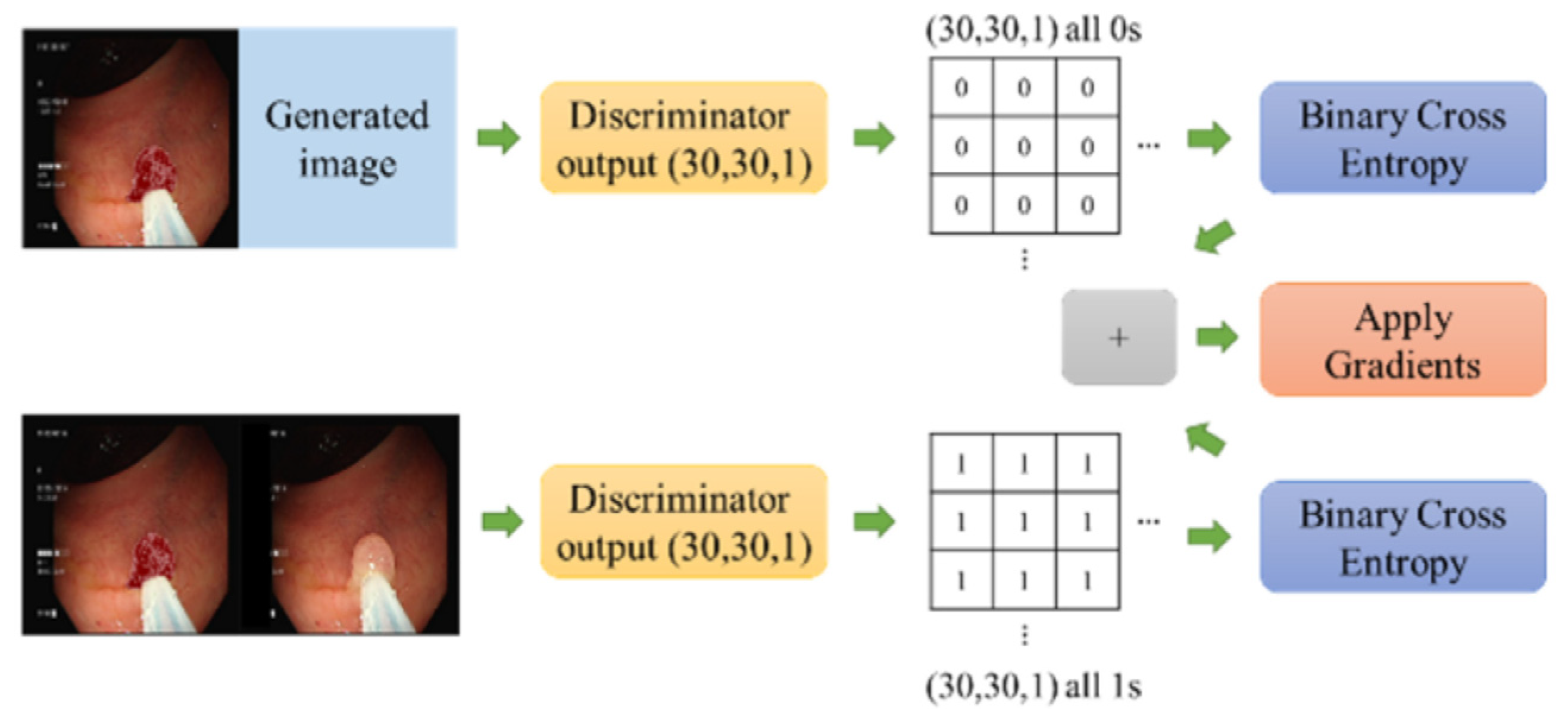
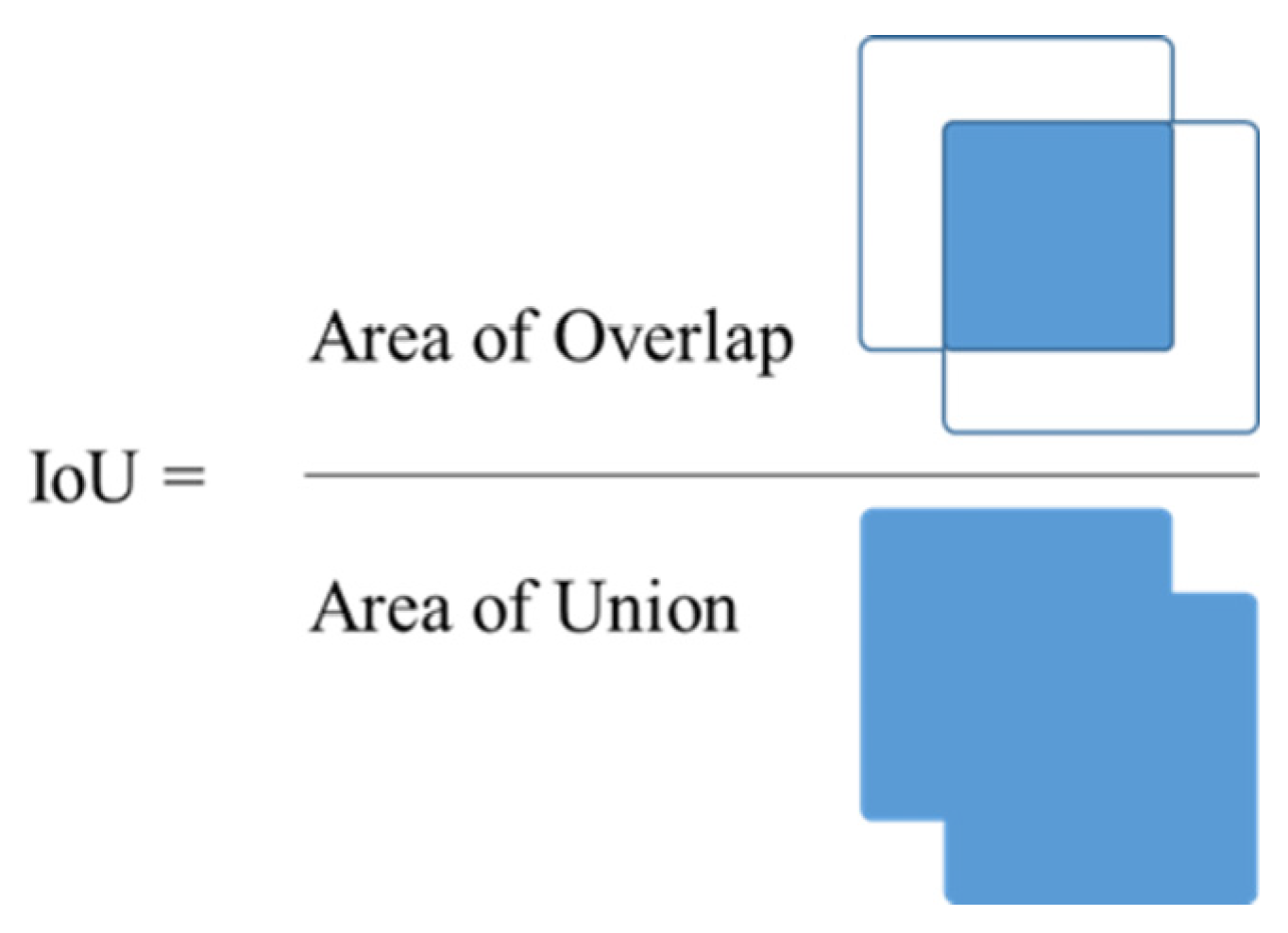
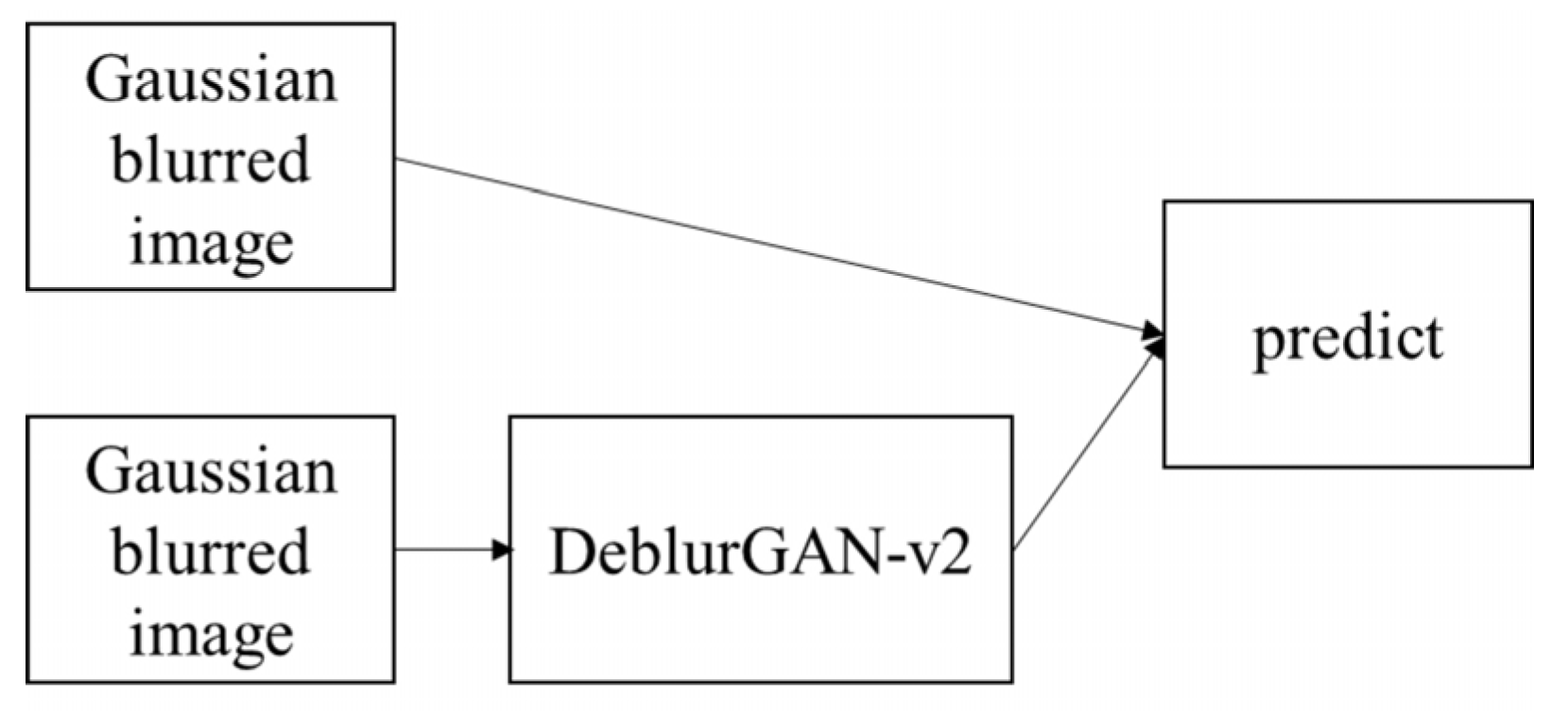
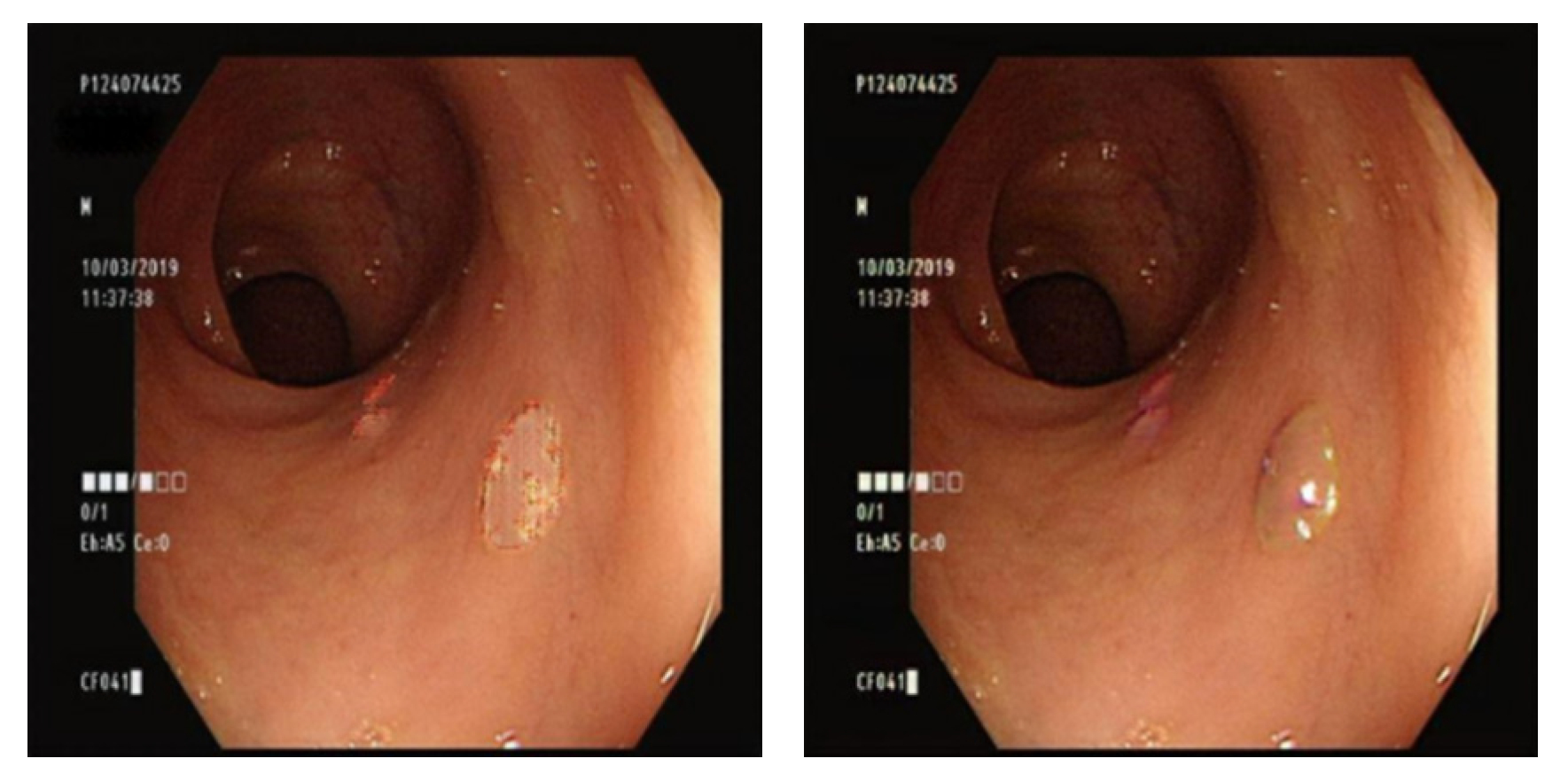
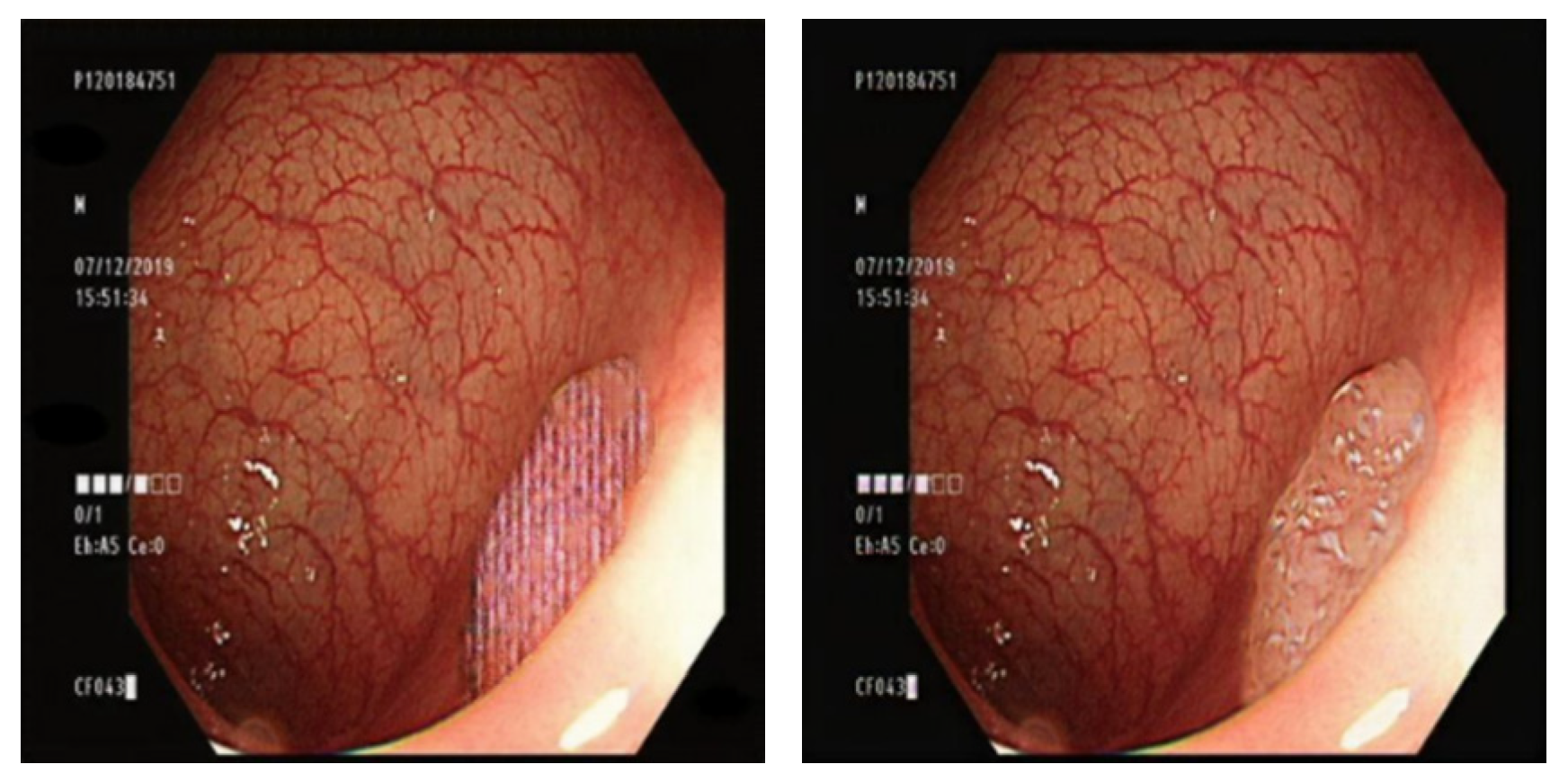
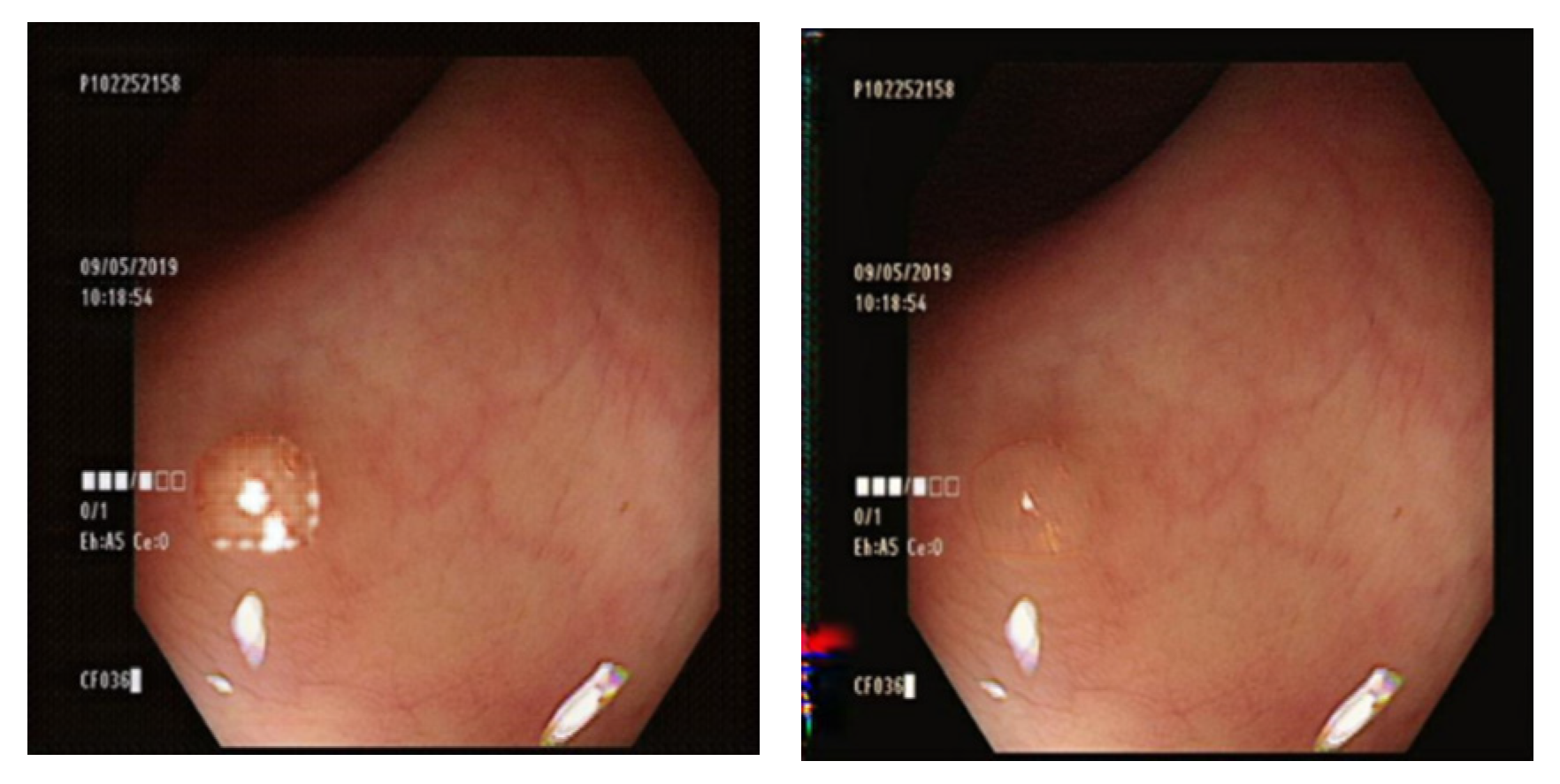
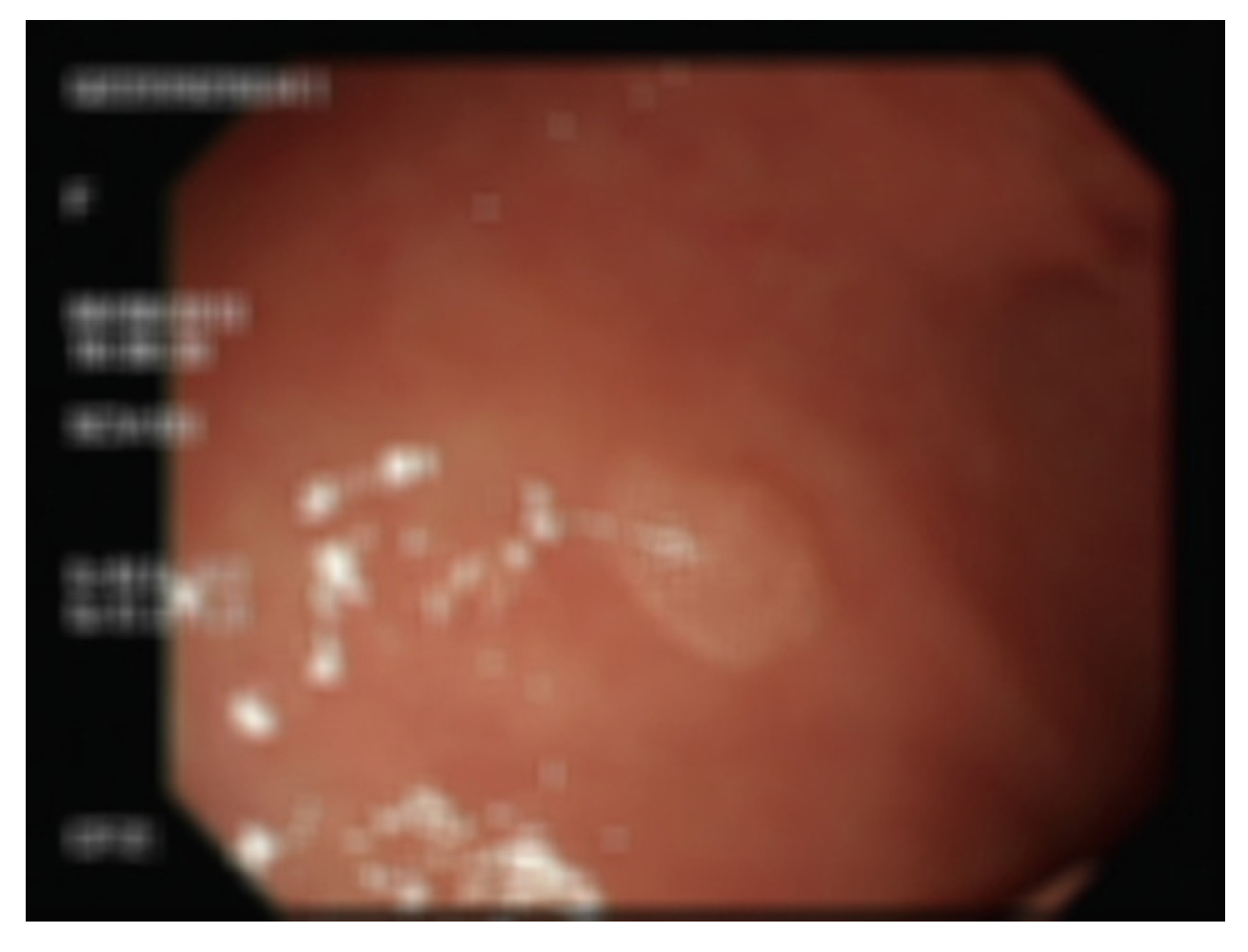
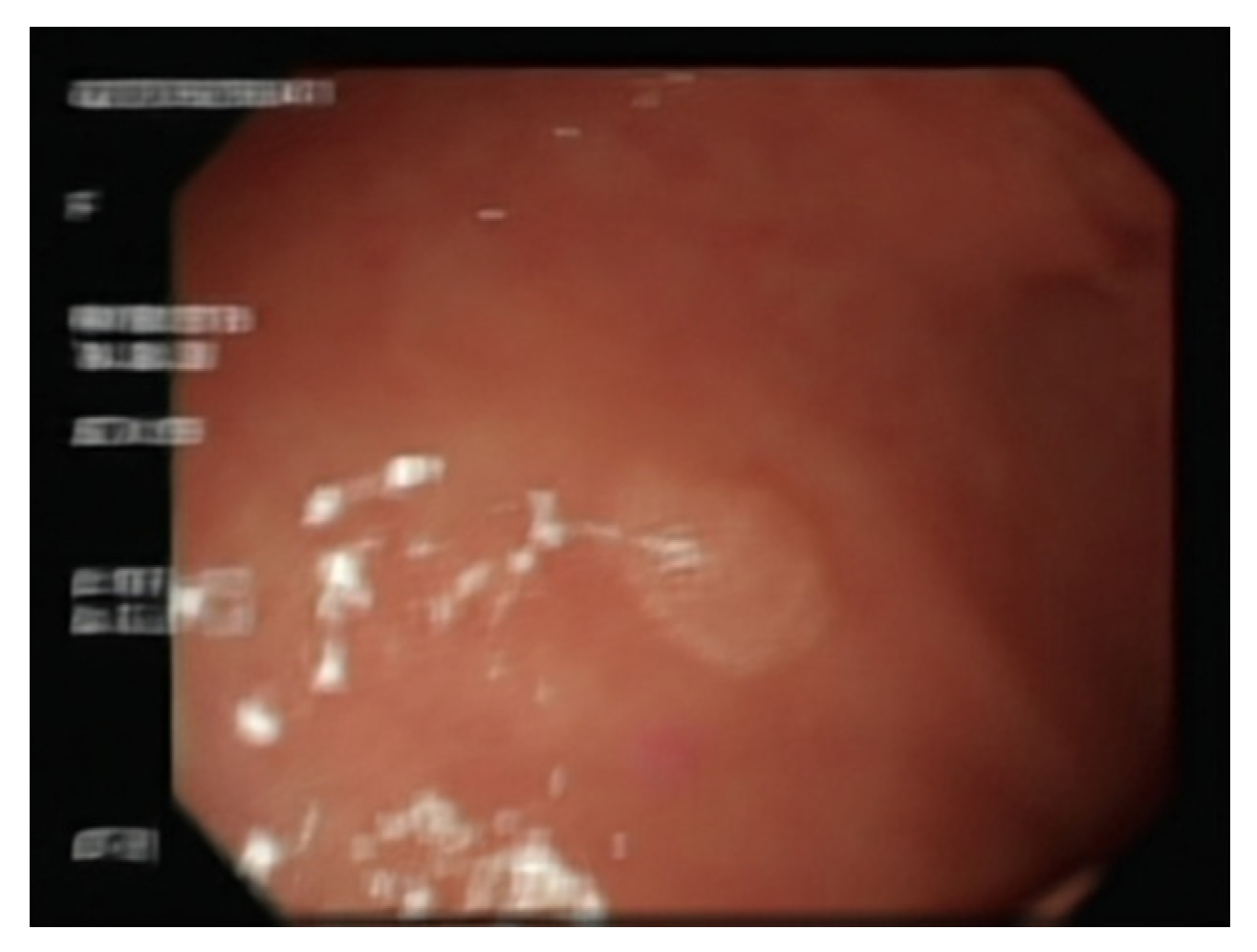

| Ori |
| Ori + Aug |
| Ori + 150 GAN |
| Ori + 300 GAN |
| Ori + 450 GAN |
| Ori + 600 GAN |
| Avg of PSNR | Avg of SSIM | |
|---|---|---|
| Pix2Pix | 24.4 | 0.92 |
| Ours | 25.7 | 0.93 |
| Avg of PSNR | Avg of SSIM | |
|---|---|---|
| Pix2Pix | 21.4 | 0.86 |
| Ours | 21.7 | 0.90 |
| Avg of PSNR | Avg of SSIM | |
|---|---|---|
| Pix2Pix | 22.8 | 0.80 |
| Ours | 23.4 | 0.82 |
| TP | FP | FN | Precision | Recall | |
|---|---|---|---|---|---|
| Ori | 102.0 | 49.6 | 68.0 | 0.67 | 0.60 |
| Ori + Aug | 105.4 | 47.8 | 64.6 | 0.69 | 0.62 |
| 150 GAN | 111.4 | 47.6 | 58.6 | 0.70 | 0.66 |
| 300 GAN | 110.8 | 49.8 | 59.2 | 0.69 | 0.65 |
| 450 GAN | 106.0 | 54.8 | 64.0 | 0.66 | 0.62 |
| 600 GAN | 109.6 | 53.8 | 60.4 | 0.67 | 0.65 |
| SSA | TA | HP | mAP | IoU | |
|---|---|---|---|---|---|
| Ori | 52.03% | 72.42% | 75.72% | 66.71% | 54.83% |
| Ori + Aug | 53.56% | 72.55% | 76.98% | 67.70% | 55.26% |
| 150 GAN | 54.08% | 75.17% | 80.97% | 70.07% | 57.24% |
| 300 GAN | 54.60% | 75.41% | 77.36% | 69.12% | 55.53% |
| 450 GAN | 51.56% | 71.62% | 77.66% | 66.95% | 53.44% |
| 600 GAN | 50.59% | 72.23% | 78.96% | 67.26% | 54.25% |
| TP | FP | FN | Precision | Recall | F1 | |
|---|---|---|---|---|---|---|
| G | 39.1 | 60.8 | 119.8 | 0.39 | 0.25 | 0.30 |
| D | 43.3 | 63.6 | 115.6 | 0.40 | 0.27 | 0.33 |
| SSA | TA | mAP | IoU | |
|---|---|---|---|---|
| G | 26.63% | 24.65% | 25.64% | 28.95% |
| D | 28.47% | 33.01% | 30.74% | 30.46% |
| SSA | TA | HP | mAP | IoU | |
|---|---|---|---|---|---|
| Yolov3 | 33.68% | 51.67% | 45.74% | 43.70% | 44.22% |
| Yolov4 | 44.72% | 73.03% | 71.32% | 61.72% | 52.77% |
| Yolov5 | 61.01% | 77.97% | 78.06% | 72.37% | 45.80% |
| YoloR | 58.28% | 77.18% | 76.62% | 70.67% | 45.83% |
| YoloX | 57.12% | 75.79% | 76.73% | 69.88% | 46.12% |
| TP | FP | FN | Precision | Recall | |
|---|---|---|---|---|---|
| Yolov3 | 58.20 | 36.1 | 125.7 | 0.62 | 0.32 |
| Yolov4 | 111.1 | 55.3 | 72.80 | 0.67 | 0.61 |
| Yolov5 | 138.5 | 41.2 | 45.40 | 0.76 | 0.67 |
| YoloR | 129.5 | 64.4 | 54.40 | 0.67 | 0.70 |
| YoloX | 155.2 | 67.4 | 28.70 | 0.70 | 0.84 |
| Range of Accuracy | Range of Error | Standard Deviation | |
|---|---|---|---|
| Yolov3 | 35.8% (min.)~46.8% (max.) | 43.70% ± 1.00% | 3.27% |
| Yolov4 | 59.7% (min.)~66.6% (max.) | 61.72% ± 1.52% | 2.25% |
| Yolov5 | 68.5% (min.)~75.8% (max.) | 72.37% ± 0.60% | 2.86% |
| YoloR | 64.0% (min.)~73.8% (max.) | 70.67% ± 5.01% | 3.13% |
| YoloX | 66.4% (min.)~75.5% (max.) | 69.88% ± 3.07% | 3.27% |
| Img-Size | 640 | 1280 | |
|---|---|---|---|
| Epochs | |||
| 200 | 65.47% | 52.52% | |
| 300 | 67.06% | 59.95% | |
| The highest value | 73.47% (Epoch = 352) | 66.89% (Epoch = 360) | |
| 400 | 71.71% | 61.84% | |
| 500 | 70.29% | 64.87% | |
| 600 | 70.25% | 62.96% | |
| 700 | 70.45% | 62.39% | |
| 800 | 70.65% | 63.84% | |
| 900 | 71.35% | 62.60% | |
| Model Name | Layers | Parameters | Inference Speed |
|---|---|---|---|
| Yolov5n | 213 | 1,779,460 | 10.3 ms |
| Yolov5s | 213 | 7,050,580 | 9.8 ms |
| Yolov5m | 213 | 1,779,460 | 10.2 ms |
| Yolov5l | 367 | 46,183,668 | 9.9 ms |
| Yolov5x | 444 | 86,267,620 | 11.2 ms |
| Yolov5n | Yolov5s | Yolov5m | Yolov5l | Yolov5x | |
|---|---|---|---|---|---|
| Precision | 0.7857 | 0.7452 | 0.7806 | 0.8018 | 0.7559 |
| Recall | 0.6874 | 0.6453 | 0.6720 | 0.6765 | 0.6874 |
Disclaimer/Publisher’s Note: The statements, opinions and data contained in all publications are solely those of the individual author(s) and contributor(s) and not of MDPI and/or the editor(s). MDPI and/or the editor(s) disclaim responsibility for any injury to people or property resulting from any ideas, methods, instructions or products referred to in the content. |
© 2023 by the authors. Licensee MDPI, Basel, Switzerland. This article is an open access article distributed under the terms and conditions of the Creative Commons Attribution (CC BY) license (https://creativecommons.org/licenses/by/4.0/).
Share and Cite
Tang, C.-P.; Chang, H.-Y.; Wang, W.-C.; Hu, W.-X. A Novel Computer-Aided Detection/Diagnosis System for Detection and Classification of Polyps in Colonoscopy. Diagnostics 2023, 13, 170. https://doi.org/10.3390/diagnostics13020170
Tang C-P, Chang H-Y, Wang W-C, Hu W-X. A Novel Computer-Aided Detection/Diagnosis System for Detection and Classification of Polyps in Colonoscopy. Diagnostics. 2023; 13(2):170. https://doi.org/10.3390/diagnostics13020170
Chicago/Turabian StyleTang, Chia-Pei, Hong-Yi Chang, Wei-Chun Wang, and Wei-Xuan Hu. 2023. "A Novel Computer-Aided Detection/Diagnosis System for Detection and Classification of Polyps in Colonoscopy" Diagnostics 13, no. 2: 170. https://doi.org/10.3390/diagnostics13020170
APA StyleTang, C.-P., Chang, H.-Y., Wang, W.-C., & Hu, W.-X. (2023). A Novel Computer-Aided Detection/Diagnosis System for Detection and Classification of Polyps in Colonoscopy. Diagnostics, 13(2), 170. https://doi.org/10.3390/diagnostics13020170






